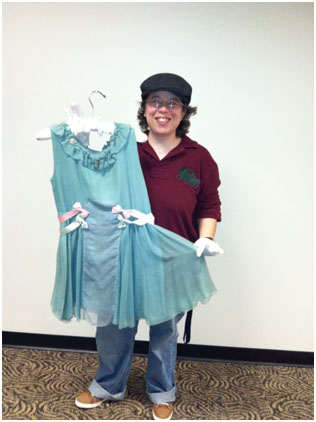Story
History and Fashion
Students are weaving fashion and history together in a unique project involving the Fashion Merchandising and Retail Marketing program at Johnson & Wales University's Denver campus and the History Colorado education department’s fashion collection. Working with historic garments from the 1860s to the 1950s—including menswear, children’s clothes, and Colorado First Ladies’ dresses—students will write two-part blogs about a select garment, recording its time period, elements specific to its era, its wearers, when it would be worn, and other interesting information. Students will write research papers about how their garment influenced styles of the last fifty years and how it translates to the twenty-first century. They’ll also include the silhouette, fiber and color, fabrication details, and the garment’s symbolism. The project’s goal is to have the students identify and analyze the psychological, social, aesthetic, economic, technological, religious, and geographic factors that influence dress.
The Johnson & Wales University Denver Fashion History project is being coordinated with History Colorado Center as part of the Capstone Project for the RTL3055 Global Influences on Fashion course.
Selecting a Piece of History, by Xena Ryan
A term project involving working with a historical garment is as exciting as it is intriguing. I was thrilled to learn that there was an option of selecting a child’s costume, as children’s fashion is of great interest to me. I’m looking forward to studying the history of the specific garment I chose and how it will relate, in part, to an industry I hope to become a part of.
When I arrived at the storage facility of the History Colorado Center, I was anxious to see the collection of fashions that are a part of our collective history, both as a people and as a state. The fabric relics of humanity’s past each claim a piece of the fashion history puzzle, each a segment on the timeline that helped to drive a continually growing industry of glamour and dreams.
Standing in the storage space of rolling racks filled with soft garment bags, I briefly wondered about the history of theses items, who wore them, where they came from, and how they’d survived. Each rack contained a small time capsule of an era: the modest styles worn by women in the 1860s while presenting themselves in public to what they relaxed in at home, progressing to the fun and creativity of evolving styles of the 1950s and 60s. One thing that struck me was how sizing differed from today’s apparel items. Women in days gone by were seemingly much smaller and petite by 21st century standards, their garments ranging from almost child-sized to a present-day size 0–2.
Once I began to pour over the racks containing the children’s apparel, it became difficult to tell a young women’s outfit from a child’s. All of the items I looked at were for girls, appearing to range in age from a young child to late teens/early adulthood. Styles ranged from sheath-type dresses to a vintage skating costume, to a two-piece suit consisting of a jacket and skirt.
The first dress I looked at ended up becoming my selected garment. It is a sea foam green silk dress from the 1930s, possibly a size medium or large (anywhere from a girl’s size 8–12), which appears to be homemade on a sewing machine with hand stitched details, such as a gathered ruffle at the neckline and pink and green ribbons at the waist. Reflection on the occasion for the little dress recalls a childhood staple, a birthday party, or perhaps the garment was made for a wedding or some other special event. I wondered if the family had money, whether the dress was a necessary item or a frivolous one, and how many times it had been worn and how it had survived the last eighty years. According to museum records, its origin is unknown. However, the construction, color choice, and style may speak volumes about the era. Its historical mystery is something I look forward to uncovering.

